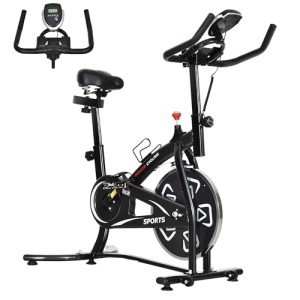The Versatility and Benefits of Stationary Bicycles
In an era where health and fitness are critical, stationary bicycles have emerged as a popular and effective tool for maintaining physical well-being. These devices, typically found in homes, gyms, and rehab centers, use a large range of benefits, from cardiovascular health to weight management. This short article explores the multifaceted world of stationary bicycles, exploring their types, benefits, and how to pick the right one for your requirements.
What is a Stationary Bicycle?
A stationary bicycle, likewise referred to as a spin bike, exercise bike, or indoor cycle, is a gadget developed to mimic the action of riding a standard bicycle but in a fixed location. Unlike outdoor cycling, stationary bicycles offer a regulated environment that enables users to focus on their workout without the diversions or threats of road conditions. These bikes are available in different kinds, each tailored to particular fitness objectives and preferences.
Kinds Of Stationary Bicycles
Upright Bicycles
- Description: These bikes closely resemble standard outside bicycles. Excersise Bike provide a more upright riding position, which can be simpler on the back and neck.
- Best For: General fitness, weight reduction, and low-impact exercises.
Recumbent Bicycles
- Description: Recumbent bikes include a reclined seating position with a back-rest, making them more comfortable for extended use.
- Best For: Users with back or joint problems, senior citizens, and those recovering from injuries.
Spin Bicycles
- Description: Spin bikes are designed for high-intensity interval training (HIIT) and cycling classes. They typically have a much heavier flywheel for a more reasonable road feel.
- Best For: Athletes, fitness enthusiasts, and those trying to find extreme workouts.
Dual-Action Bicycles
- Description: These bikes incorporate handles that move with the pedals, offering an upper body workout in addition to lower body exercise.
- Best For: Full-body workouts and increased calorie burn.
Benefits of Using a Stationary Bicycle
Cardiovascular Health
- Regular usage of a stationary bicycle can considerably improve cardiovascular health by enhancing the heart and lungs. It helps lower the threat of heart problem, hypertension, and stroke.
Weight Management
- Cycling is an outstanding method to burn calories and manage weight. A 30-minute session can burn in between 200 and 300 calories, depending upon intensity and private factors.
Low-Impact Exercise
- Stationary bicycles supply a low-impact workout, making them perfect for people with joint pain, arthritis, or other conditions that restrict high-impact activities.
Mental Health
- Exercise, including cycling, launches endorphins, which are natural state of mind lifters. Regular use of a stationary bicycle can help lower stress, anxiety, and depression.
Convenience and Accessibility
- Unlike outside cycling, stationary bikes can be used anytime, no matter weather conditions or time restrictions. They are likewise available to people of any ages and fitness levels.
How to Choose the Right Stationary Bicycle
Determine Your Fitness Goals
- Consider what you desire to attain with your exercises. Are you looking to enhance cardiovascular health, lose weight, or build muscle?
Evaluate Your Physical Condition
- If you have any health issues or physical limitations, pick a bike that accommodates your needs. Recumbent bikes are frequently a great choice for those with back or joint issues.
Evaluate Your Space
- Measure the location where you prepare to put the bike to ensure it fits comfortably. Some bikes are more compact than others.
Consider Additional Features
- Search for features that enhance your workout experience, such as resistance settings, heart rate displays, and integrated workout programs.
Check Out Reviews and Testimonials
- Research various designs and check out reviews from other users to get a concept of their efficiency and durability.
FAQs
Q: Are stationary bicycles effective for weight-loss?
- A: Yes, stationary bicycles are highly effective for weight-loss. They supply a low-impact, calorie-burning workout that can be adapted to suit numerous fitness levels.
Q: Can I use a stationary bicycle if I have knee issues?
- A: Yes, stationary bicycles are usually low-impact and can be a great option for individuals with knee problems. Recumbent bikes, in particular, deal additional assistance and are much easier on the joints.
Q: How frequently should I use a stationary bicycle for optimum outcomes?
- A: For optimal results, goal to use a stationary bicycle for a minimum of 30 minutes, 3-5 times weekly. Consistency is crucial to achieving your fitness objectives.
Q: Do stationary bicycles supply a full-body workout?
- A: While stationary bicycles primarily target the lower body, some designs, like dual-action bikes, also engage the upper body. For a more comprehensive workout, consider integrating other exercises.
Q: Can I use a stationary bicycle for interval training?
- A: Yes, many stationary bicycles offer resistance settings and built-in programs that are perfect for interval training. Spin bikes, in specific, are designed for high-intensity interval training (HIIT).
Stationary bicycles are a flexible and important addition to any fitness regimen. Whether you are a skilled professional athlete or a fitness amateur, there is a stationary bike that can help you achieve your health and health objectives. By comprehending the different kinds of bikes, their benefits, and how to select the ideal one, you can make a notified choice that will boost your overall fitness journey. So, get on a stationary bicycle and begin pedaling your way to a much healthier, better you.

